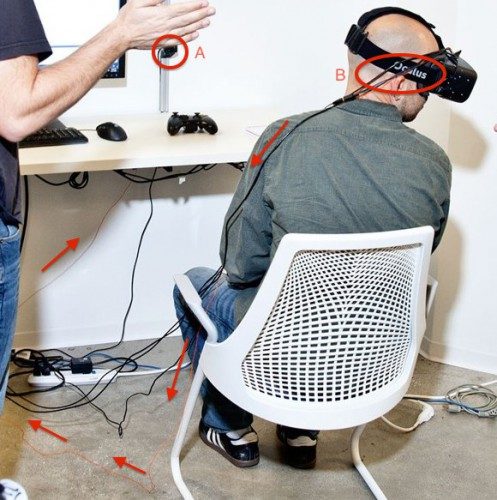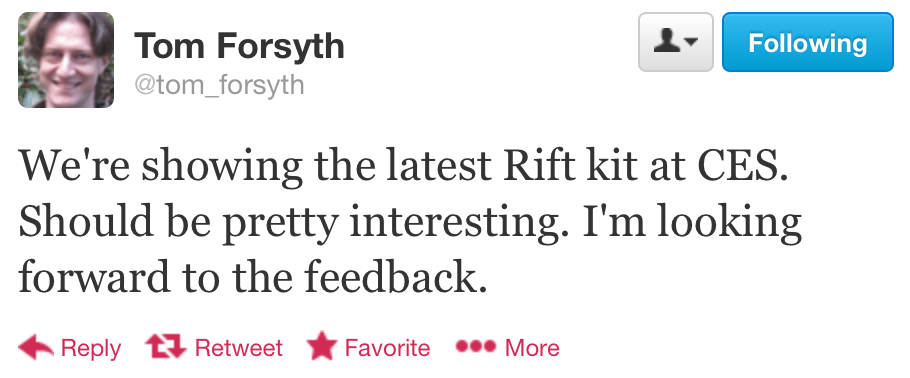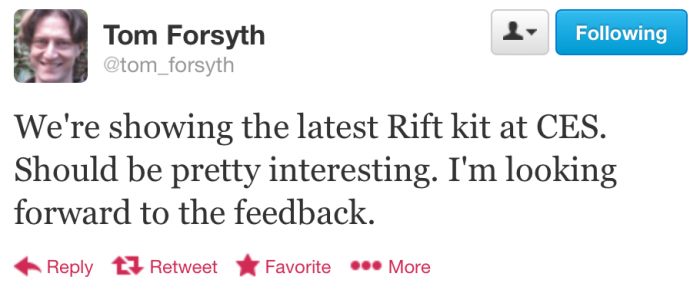A tweet sent my Oculus VR Software Engineer Tom Forsythe seems to finally confirm that a new Oculus Rift prototype will be shown at CES 2014. Here’s a roundup the credible speculation on the next generation Oculus Rift.
Confirmation at Last
We’ve been fairly sure that CES 2014 would prove to be the place Oculus would choose to reveal the first new updated version of its Oculus Rift headset for a little while now. But up to now, Oculus VR have been tight lipped on the subject. That was until Tom Forsythe, Software Engineer at Oculus VR tweeted:
No further details were forthcoming unfortunately, but at least we know for sure we’ll be seeing something new. So, what might that something be? We thought it might be interesting to collect what we see as the recent, credible speculation recent surrounding this new hardware.
Positional Tracking and That Wired Article
One of the key elements missing from all Oculus Rift hardware either available or shown publicly until now is the ability track the user’s position in 3D space. The disconnect caused by lateral movement by a user inside the Rift and the image offered to the user is tough for the brain to deal – positional tracking allows the view to be updated accordingly. Aside from a higher resolution display and reducing latency, this is the feature Oculus VR have confirmed must be present before the consumer version ships later this year.
 Last week, Road to VR stumbled across some details hidden away in an image used in a recent Wired article where their reporter apparently tried at least one newer edition of the Oculus Rift and was pictured using it. In the enhanced (no, not like CSI or Blade Runner) image we see what seems to be an extra orange cable leaving the headset (B) and tracing to what seems to be a wall mounted camera (A). Additionally, the chair the user is sat in, seems to have been positioned specifically against some masking taped boundaries. Could this be a new optical positional tracking system? After publishing our thoughts, we took to /r/oculus to discuss it further.
Last week, Road to VR stumbled across some details hidden away in an image used in a recent Wired article where their reporter apparently tried at least one newer edition of the Oculus Rift and was pictured using it. In the enhanced (no, not like CSI or Blade Runner) image we see what seems to be an extra orange cable leaving the headset (B) and tracing to what seems to be a wall mounted camera (A). Additionally, the chair the user is sat in, seems to have been positioned specifically against some masking taped boundaries. Could this be a new optical positional tracking system? After publishing our thoughts, we took to /r/oculus to discuss it further.
User erikvonvicious offers an excellent theory on what that orange wire’s purpose might be and whether those dots seen on the side of the HMD are important:
That orange wire is almost certainly a trigger wire. if you had a 4 point box of ir leds on multiple sides of the rift or other pattern the camera could see then you could fairly easily track a player like the Wii remote does, a well known example is this video (2007 warning) as long as the camera could pick up any 2 points from the rifts 5 surfaces not attached to your face and not confuse which ones they were you could interpret where it is and how its pointing. in reality you probably would only need a few leds since much of the assumed position/rotation can be checked against what the accel/gyro/mag sensor fusion output is.
How the rift would accomplish the “not mixing up the leds” could simply be by flashing them and precisely knowing their timing compared to the cameras current frame after syncing via that orange wire. this could be done via the HDMI i2c line, USB, or possibly wireless, so in the future consumer version its not needed as a free floating wire. they could even just have the rift do a known flash pattern when needed to recalibrate on the fly.
User TheSonicRetard adds:
I wonder (assuming this is indeed IR tracking) if this will augment some sort of internal gyroscopic tracking. IR tracking has a line of sight problem that runs counter to the rift’s “all around you, 360 degrees” design. It’s the same problem the Wiimote pointer had when you weren’t pointing at the screen. Using IR tracking as a global positioning system to re-orient every now and then is preferable (even smart, it corrects for drift) but, unless we’re going to be expected to put these trackers all around us, it’ll run into the same problems IR tracking always has.
A mix of gyroscopic positioning using IR sights to re-orient every now and then would be most preferable.
Both theories provide an excellent explanation for what we see in the image. Of course, there’s no way to know if the HMD seen above is even a path Oculus VR are pursuing, it’s entirely possible the unit is just one of the many experiments their engineers have in an effort to resolve this problem. We’ll have to wait a couple of days to find out for sure. You can read the entire thread here.
We’ll have more for you later in the week when we meet with Oculus and finally get to see what secrets they’ll be revealing. Remember to follow us on Twitter for the latest news as CES 2014 progresses.








